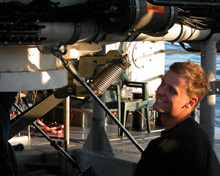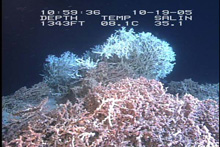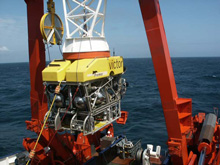
Dr. Murray Roberts prepares to enter the stern compartment of the Johnson-Sea-Link submersible for his first dive. Click image for larger view and image credit.
Exploring Cold-Water Reefs by Submersible
October 20, 2005
J Murray Roberts
Marine Biologist
Scottish Association for Marine Science
Thanks to funding from the Royal Society of Edinburgh I’ve been able to travel from the UK to join this RV Seward Johnson cruise to the cold-water coral reefs of the Carolinas to Florida. I’ve studied cold-water coral ecosystems since 1997 working on European Lophelia reefs and carbonate mounds from the Porcupine Seabight (SW Ireland) in the south to the west of Scotland and the Norwegian continental shelf in the north. To join this cruise brings several welcome changes – rather than going progressively further north over the Arctic Circle, we are gradually steaming south towards Fort Pierce, Florida. Outside temperatures are warm, even hot, and we can work in shorts without the fleece jackets and foul weather gear that seem obligatory year-round in the north-east Atlantic!
More importantly, this is my first opportunity to see cold-water coral
reefs in situ from a manned submersible. While these are used to study
cold-water coral reefs by some European institutes (notably the German
JAGO sub), the vast majority of this work is done using deep-water camera
systems or remotely operated vehicles (ROVs). Using these, the scientists
remain on deck and rely on the pictures transmitted back to the surface.
You can see examples of the images collected from European cold-water
coral reefs at www.lophelia.org ![]() . However,
nothing can replace the overall understanding of the deep-water reef
environment you gain by actually visiting it. Terrestrial scientists take
this for granted – it’s hard to imagine an ornithologist who has never
walked through the woods and heard birdsong – but only a handful of
deep-sea biologists ever get the chance to see the ecosystems they study.
. However,
nothing can replace the overall understanding of the deep-water reef
environment you gain by actually visiting it. Terrestrial scientists take
this for granted – it’s hard to imagine an ornithologist who has never
walked through the woods and heard birdsong – but only a handful of
deep-sea biologists ever get the chance to see the ecosystems they study.
Today was my first experience of manned submersible work. I dived with a co-pilot in the stern compartment of the Johnson-Sea-Link sub while Steve Ross and the pilot were in the bow, a large acrylic sphere with a wide field of view. In the stern the two of us lie or sit cross-legged, bent double, in a space 3 feet high and 7 feet long. There are two portholes on either side that allow you to see the outside world. As the sub descends, light levels drop rapidly and we are soon in total darkness. On reaching the bottom we tracked across a sandy seabed, towards the first reef area. These reefs rise up steeply reaching heights of up 70 m above the surrounding seabed and the sub was able to navigate the rugged terrain pausing to photograph and sample the diverse animal community living there.
Having seen the reefs from the portholes of the stern compartment, I’m now excited at the thought of my first dive in the acrylic sphere at the bow and getting to experience this unique viewpoint on these reefs of the deep.
Life on the Edge will be sending daily reports from Oct 16 - Nov 4. Please check back frequently for additional logs from this expedition.
Sign up for the Ocean Explorer E-mail Update List.



























